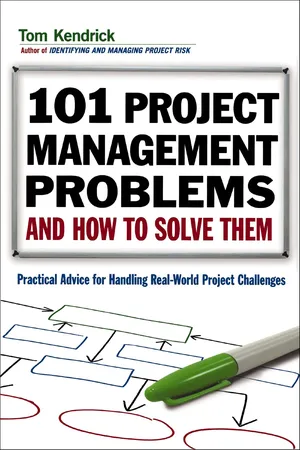
101 Project Management Problems and How to Solve Them
Practical Advice for Handling Real-World Project Challenges
- 208 pages
- English
- ePUB (mobile friendly)
- Available on iOS & Android
101 Project Management Problems and How to Solve Them
Practical Advice for Handling Real-World Project Challenges
About this book
In this helpful how-to, author Tom Kendrick reveals field-proven principles for navigating high-pressure situations, so you can overcome any obstacle.
Even with a terrific project management program in place, problems can arise to derail your team's hard work. This book explores a wide range of challenging scenarios and practical solutions and is packed with insightful answers to over 100 of your most urgent project management questions.
In 101 Project Management Problems and How to Solve Them, you'll learn how to:
- keep a project on track despite unavoidable interruptions;
- how to prevent unreliable outside collaborators from jeopardizing the entire project;
- how to manage project teams who have little or no project management experience;
- how to make up for lost time without cutting corners;
- and how to succeed--even in the face of threatened budget cuts.
The last thing you need in the heat of battle is to dive into project management theories. While there's no one right answer to the challenges you face as a project manager, 101 Project Management Problems and How to Solve Them has a plethora of actionable guidelines that help you troubleshoot quickly so you can get back to doing what you do best.
Frequently asked questions
- Essential is ideal for learners and professionals who enjoy exploring a wide range of subjects. Access the Essential Library with 800,000+ trusted titles and best-sellers across business, personal growth, and the humanities. Includes unlimited reading time and Standard Read Aloud voice.
- Complete: Perfect for advanced learners and researchers needing full, unrestricted access. Unlock 1.4M+ books across hundreds of subjects, including academic and specialized titles. The Complete Plan also includes advanced features like Premium Read Aloud and Research Assistant.
Please note we cannot support devices running on iOS 13 and Android 7 or earlier. Learn more about using the app.
Information
PART 1: GENERAL
1. What personality type fits best into project management?


Understanding Personality Types
Considering Other Factors
2. What are the habits of successful project managers?
Defining Your Working Style
Referring to an Old List











3. I’m an experienced individual contributor but very new to project management. How do I get my new project up and going?



Getting Started
Engaging Your Team
Choosing Your Approach
Table of contents
- Cover Page
- Title Page
- Copyright Page
- Dedication
- Contents
- Introduction: Explanations
- Part 1: General
- Part 2: Initiation
- Part 3: Teamwork
- Part 4: Planning
- Part 5: Execution
- Part 6: Control
- Part 7: Tools
- Part 8: Closing
- Index